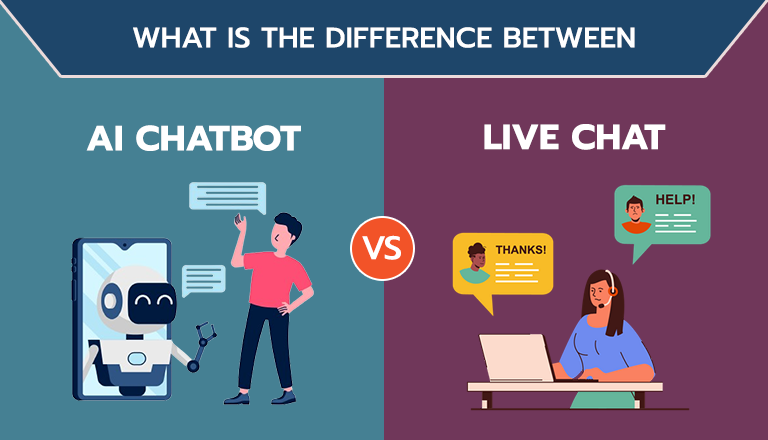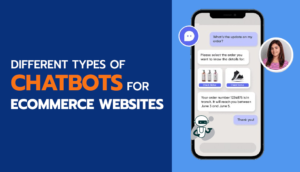Have you ever landed on a website and been greeted by a friendly pop-up window offering to answer your questions? Or perhaps you’ve contacted customer service and found yourself interacting with a helpful (though not human) assistant? These are both examples of chatbots, a rapidly growing technology transforming the way businesses interact with customers.
But chatbots aren’t the only game in town. Traditional live chat systems, where you connect with a real person, are still widely used.
So, how do you know which option is right for your business? This blog post will equip you with the knowledge to make an informed decision.
What are AI Chatbots?
AI chatbots, also known as virtual assistants or conversational AI, are powered by artificial intelligence and natural language processing (NLP) technologies. These chatbots use machine learning algorithms to understand and interpret human language, allowing them to engage in natural conversations and provide relevant responses.
AI chatbots are designed to mimic human-like interactions by recognizing intent, extracting key entities, managing dialogue flow, and generating contextually appropriate responses.
Advantages
- 24/7 Availability: AI chatbots operate around the clock, ensuring customer support is available at any time, day or night.
- Cost-Effective: Implementing AI chatbots can significantly reduce labor costs associated with human customer service representatives.
- Scalability: AI chatbots can handle multiple conversations simultaneously, making them highly scalable to meet fluctuating customer demand.
- Consistent Responses: AI chatbots provide consistent and standardized responses, ensuring a uniform customer experience.
- Multi-lingual Support: AI chatbots can be trained to communicate in multiple languages, facilitating global customer service.
Limitations
- Limited Understanding: AI chatbots may struggle with complex or nuanced queries, as their understanding is limited by the training data and algorithms.
- Lack of Emotional Intelligence: AI chatbots lack the ability to truly empathize or understand human emotions, which can be crucial in certain customer service scenarios.
- Complex Queries: While improving, AI chatbots may still have difficulty resolving intricate or multi-faceted customer issues.
- Training Data Quality: The performance of AI chatbots is heavily dependent on the quality and quantity of the training data used to develop them.
What are Live Chats?
Live chats, on the other hand, involves human customer service representatives communicating with customers in real-time through chat interfaces. These chat tools rely on human operators to respond to customer inquiries, provide personalized assistance, and resolve issues.
In a live chat session, customers can initiate a conversation by clicking on a chat button or widget typically displayed on the website or within the application. They can then type their queries or concerns, and a live agent will respond in real-time, facilitating a back-and-forth dialogue.
Advantages
- Empathy and Emotional Intelligence: Human agents possess the ability to empathize, understand emotions, and provide personalized support, which can be crucial in building customer trust and loyalty.
- Complex Problem-Solving: Live chat agents can draw upon their knowledge and experience to address complex or unique customer issues that may be challenging for AI chatbots.
- Personalized Interactions: With human agents, customers can engage in more personalized and tailored interactions, fostering stronger customer relationships.
- Building Customer Relationships: Live chat agents can establish rapport and build long-term connections with customers, leading to increased customer satisfaction and loyalty.
Limitations
- Staffing Costs: Maintaining a team of live chat agents can be a significant financial burden for businesses, especially small and medium-sized enterprises.
- Limited Availability: Traditional live chat support is often restricted to standard business hours, leaving customers frustrated and unattended outside of those times.
- Potential Inconsistencies: The quality of service provided by live chat agents can vary significantly depending on their level of experience, knowledge, and availability.
- Language Barriers: Offering live chat support in multiple languages can pose a significant challenge for businesses operating globally or catering to diverse customer bases.
Key Differences: AI Chatbots vs Live Chat
Now that we’ve explored the strengths and weaknesses of both AI chatbots and live chat, let’s delve into the key differences that will help you decide which solution best suits your business needs:
| AI Chatbot | Live Chat | |
|---|---|---|
| Availability | Provides 24/7 service without breaks or downtimes. | Often limited to business hours, weekends, or specific time zones. |
| Cost Efficiency | High initial setup cost, but more cost-effective over time due to automation. | Ongoing costs related to staffing, training, and operations. |
| Customization and Learning | Can learn and adapt over time to provide more personalized responses based on past interactions. | Each interaction is unique and may not contribute to long-term personalization. |
| Scalability | Easily scales to handle thousands of conversations simultaneously. | Scaling requires additional staffing, which can be costly and slow. |
| User Experience | Instant responses improve engagement but may lack the empathetic touch of human interaction. | Provides a human touch that can lead to more satisfying customer interactions, though responses might be slower. |
| Consistency | Offers consistent responses to customer inquiries, based on the programmed knowledge base. | Response quality can vary due to human factors like mood, fatigue, or experience. |
| Multilingual Support | Can support multiple languages simultaneously without extra costs. | Offering support in multiple languages requires diverse staff and can be resource-intensive. |
| Complex Inquiries | May struggle with complex queries that require human judgment and empathy. | Ideal for handling complex queries that require a nuanced and personalized response. |
| Data Collection and Analysis | Can collect and analyze customer data, providing valuable insights for business optimization. | Data collection and analysis may be more limited and subject to human error. |
Use Cases for AI Chatbots and Live Chat
AI chatbots and live chats serve different purposes and fit various industry needs based on their unique capabilities. Here’s an exploration of real-world use cases for both technologies, with examples and guidance on which industries might prefer one solution over the other.
AI Chatbots Use Cases:
- E-commerce and Retail: AI chatbots can provide instant customer service, answering FAQs about products, processing returns, and tracking orders. For instance, H&M’s chatbot offers personalized outfit recommendations based on user responses.
- Banking and Finance: Banks and financial institutions can use chatbots for basic account inquiries, transaction history, and general information about products and services.
- Travel and Hospitality: Hotels, airlines, and travel agencies can use chatbots to handle booking inquiries, provide flight or hotel information, and assist with basic trip planning.
- Education: Educational institutions can use chatbots to answer frequently asked questions about admissions, course offerings, and campus resources.
Live Chat Use Cases:
- High-value Sales and Services: Industries where customer purchases have a high value, such as real estate and luxury goods, benefit from live chats. Personal interaction can provide the detailed, nuanced communication that high-stakes purchases require.
- Tech Support and IT Services: Complex technical issues often need human expertise to understand and resolve problems effectively. Companies like Dell and HP utilize live chat to offer real-time tech support.
- Healthcare Consulting: For sensitive health issues or detailed medical consultations that require empathy and understanding, live chat with real healthcare professionals can provide the necessary support and confidentiality.
- Legal Services: Potential clients looking for legal advice may have complex issues that require detailed discussion. Law firms often use live chat to offer initial consultations and gauge the nature of legal inquiries.
- Consulting Services: Industries like consulting or professional services benefit from live chat’s ability to offer tailored advice, address complex inquiries, and build strong client relationships.
Which industries should use which solution?
- AI Chatbots are best suited for industries with high volumes of customer inquiries where the questions are relatively standard and can be automated. E-commerce, basic healthcare triage, customer service for utilities, and simple financial inquiries are prime candidates for AI chatbot integration.
- Live Chat is ideal for industries where personal service, complex decision-making, and empathy are crucial. High-value sales, complex tech support, healthcare consulting, and legal advice benefit significantly from the human touch that live chat provides.
Combining AI Chatbots with Live Chat:
To leverage the strengths of both AI chatbots and live chat, many businesses are adopting a hybrid approach that integrates the two systems. This strategy allows for a seamless customer experience, where AI chatbots handle initial inquiries and common tasks, while escalating complex issues or queries to human agents when needed.
By combining AI and live chat, businesses can benefit from the following advantages:
- Cost Savings: The integration of AI chatbots can reduce the overall demand for human agents, leading to cost savings in staffing and operational expenses.
- Continuous Learning: AI chatbots can learn from interactions with human agents, improving their knowledge base and response capabilities over time.
- Enhanced Customer Experience: Customers can enjoy the convenience and immediacy of AI chatbots for simple tasks, while still having access to personalized human support when required.
Examples of AI Chatbots with Live Chat feature:
Here are some examples of AI chatbots with live chat features, showcasing how businesses can effectively combine automation and human interaction to drive customer satisfaction and growth.
- Tiledesk offers an AI-powered customer engagement platform with omnichannel live chat and chatbots for seamless team communication. With a free plan inclusive of live chat integration, Tiledesk enhances customer interactions effectively.
- ChatNode.ai empowers users to build advanced chatbots using OpenAI, leveraging a robust URL scrapper for diverse training sources. Users can upload various document formats to enrich bot training. The platform’s premium plan, starts at $59/month and comes with a 2-week free trial for exploration.
- WPBot is a free WordPress plugin offering an easy-to-use AI ChatBot for WordPress websites. It provides AI-powered ChatBot services using DialogFlow or OpenAI (ChatGPT) and offers intelligent live chat support with a fully integrated Live Chat WordPress plugin addon.
- Drift is a highly popular live chatbot platform used for sales, marketing, and customer service. It features Conversational AI in higher-tier plans, utilizing artificial intelligence to understand and respond to human language naturally.
- Botsonic is a powerful AI chatbot builder that employs a no-code approach to create intelligent virtual assistants. Their live chat feature is part of the business plan, facilitating team collaboration with a shared inbox for seamless communication and support.
Conclusion
The decision between AI chatbots and live chat depends on your specific business needs and budget. Consider the volume and complexity of customer inquiries, your target audience, and your desired level of customer service personalization.
Remember, the best approach might be a hybrid solution that leverages the strengths of both AI and human interaction. By carefully evaluating your options, you can equip your business with the right conversational tool to enhance customer experience and drive business growth.
FAQs
Q1. How do businesses ensure data privacy and security with AI chatbots?
Businesses must implement robust security measures to protect customer data and ensure privacy when using AI chatbots. This includes data encryption, secure storage, and adherence to relevant data protection regulations.
Q2. Can live chat agents be replaced entirely by AI chatbots?
While AI chatbots are becoming increasingly capable, they are unlikely to completely replace human agents in the near future. Live chat agents will remain essential for handling complex or sensitive customer issues that require human empathy and problem-solving skills.
Q3. How can businesses train and maintain their AI chatbots effectively?
Effective training and maintenance of AI chatbots involve providing high-quality and diverse training data, continuously updating the knowledge base with new information, and monitoring performance to identify areas for improvement.
Q4. What are the costs associated with implementing AI chatbots and live chat?
The costs of implementing AI chatbots include initial development and integration expenses, ongoing maintenance and training, and potentially hosting or subscription fees. Live chat costs primarily involve staffing and training human agents, as well as any required software or platform fees.
Q5. How can businesses train and maintain their AI chatbots effectively?
Effective training and maintenance of AI chatbots involve providing high-quality and diverse training data, continuously updating the knowledge base with new information, and monitoring performance to identify areas for improvement.
Q6. How can businesses measure the success and ROI of their AI chatbot and live chat implementations?
Key metrics for measuring success include customer satisfaction scores, resolution rates, average handling times, cost savings, and overall impact on customer retention and loyalty. Businesses should establish clear goals and metrics aligned with their specific objectives.






Share Your Thoughts: